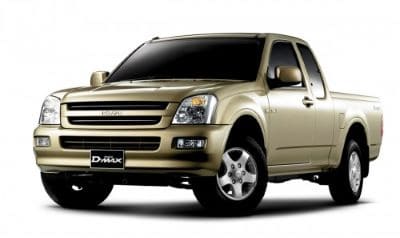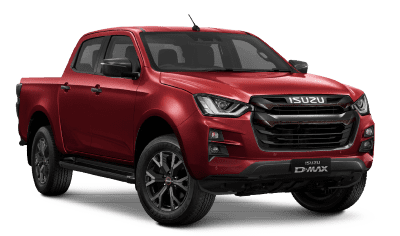UK Car Guide ›› Pickup ›› Isuzu D'Max
Isuzu D-Max Models
After winning Pick-up of the Year award from What Van? and 4x4 Magazine in 2023, it's easy to see why D-Max is ticking all the right boxes for capability, durability, and reliability.
This information and data spotlights the history of the Isuzu D'Max and timeline of the variants from 2002 through to the present day.
The History of Isuzu D-Max Pick-Up Trucks
The multinational automobile manufacturer Isuzu Motors Ltd. is based in Yokohama, Japan. Many experts still consider this Japanese automaker as being the pick-up professionals.
It all started in 1972 when Isuzu started manufacturing the KB20 / 25 series Faster pickup. Several decades later, the first generation Isuzu D-Max model became the successor to the Faster/KB.
They marketed it as the Holden Rodeo in Australia and New Zealand between 2003 and 2008. The light-duty truck also went through a relaunch and got named as the Holden Colorado in 2008.
The first generation MU-7 is the sport utility vehicle (SUV) counterpart based on the same running platform as the D-Max. Later, they renamed it to the MU-X for the succeeding generations.
D-Max Timeline: 2002 to 2024
2002: First Generation
Isuzu is not owned by General Motors. But, they have partnered with GM and several other manufacturers, including Toyota Motors and Subaru Corporation.
As a result, GM-Isuzu moved one of the joint operations from Japan to Thailand in 2002. This set the stage for the first production of the D-Max pickup truck.
In the early days, the single cab Spark EX was only available as 4x2 (e.g. two non-drive wheels). Even so, you could choose between three different configurations:
- Cab chassis
- Long bed without power steering
- Long bed with power steering
The Space Cab versions (with the extended cab), and the D-Max Cab 4 (with a double cab) had two major configurations:
- SL, SX, SLX: Standard height 4x2
- S, LS: 4x4 using the "Rodeo" nameplate
The first and second-generation D-Max models (2002 - 2019) share platforms with the Chevrolet Colorado, which made its debut in 2004.
Engines and Specifications
The earliest models used the two engine choices from its direct predecessor, the 4JH1-T 3.0 and the 4JA1-T 2.5.
But, Isuzu introduced a family of DDi iTEQ common-rail diesel engines in 2004 for the D-Max, the first was the 3.0 4JJ1-TC 146 PS (107 kW; 144 hp).
The more economical 2.5 4JK1-TC 116 PS (85 kW; 114 hp) came out early in 2005 and the third DDi iTEQ engine version arrived towards the end of 2006.
The 3.0 4JJ1-TCX was a modified 4JJ1-TC which incorporated a new Variable Valve Geometry Turbo (VGS).
 Isuzu D-Max Gold Series 2007
Isuzu D-Max Gold Series 2007
Models with the Xenon headlamps had them changed to projector headlamps. The makers also introduced the new "Hexapod-plot" interior.
The "Gold Series" models are a celebration of Isuzu's 50th anniversary in Thailand.
Plus, you could also buy the Hi-Lander Cab 4 variant with a VGS turbo diesel engine for the first time.
In 2008, the Rodeo LS and the Hi-Lander Space Cab adopted the new 3.0-litre VGS Turbo Diesel engine to fill the remaining gaps in the Isuzu lineup.
Isuzu launched the D-Max Super Platinum models in 2009. They dropped the SL model, and the Highline SLX 4x2 models got a new fascia and a new front bumper. The same year also saw the introduction of the X-Series (a sport version of the D-Max).
They marketed it as a "Lifestyle Pickup" and equipped it with additional skirts to try to attract the younger buyers. There were no changes to the wheels, but gunmetal paint finish became an option.
The last model in this generation came out in 2010. For the first time, Thai-built pickups of the D-Max and MU-7 Super Titanium featured a frontal camera.
Pro Tip: Another section contains more information about 4JJ1 engine specs and why they rank as some of the best in the world.
2011: Second Generation
The Japanese automaker unveiled the second-generation D-Max in 2011. In fact, it is almost a clone of the 2011 Chevrolet Colorado pickup truck - due to Isuzu's cooperation with General Motors.
Put another way:
The 2011 D-Max and Colorado share ladder chassis platforms ("i-GRIP"), body construction, interior design (including the dash, steering wheel, and doors), and most of the mechanical componentry.
Plus, the Isuzu Gravity Responsive Intelligent Platform that underpins the second-generation D-Max is 42% stronger (compared to its predecessors), resulting in a better ride and overall handling.
Improvements made to the rear cross bracing has produced extra stability under loads and especially while towing.
All three body styles got the standard longer wheelbase that measures 3,095 mm (121.9 inches). That is a notable 45 mm (1.8 inches) longer than the predecessors.
They renamed the Transfer case marketing name to "Terrain command" from "Touch-on-the-fly". Thus, use of a simple knob seamlessly changes the drive modes from 2-Wheel Drive mode to 4-Wheel Drive mode.
D-Max Body Styles and Safety Features
They keep the three body styles as Single Cab, Space Cab, and the Crew Cab. But, customers can choose between rear-wheel drive and four-wheel drive models. The Space Extra Cab provides easy access to the rear seat via "laterally opening doors".
Besides a number of airbags, the standard safety features include:
- Anti-lock Braking System (ABS)
- Electronic Stability Control (ESC)
- Electronic brakeforce distribution (EBD)
- Emergency brake assist
- Traction Control System (TCS)
Note: The electronic brakeforce distribution (EBD) system is able to detect the payload weight. So, it can modulate the rear braking force and compensate for increased vehicle weight.
2015 D-Max Facelift
The 2015 updated model for Thailand (RT85) had a redesigned front fascia and it got a larger grille. They also installed the new 1.9-litre RZ4E-TC turbodiesel engine.
Some minor changes on the interior included an uprated 8" inch infotainment system, cruise control, and newer Thin Film Transistor (TFT) gauges.
2017 D-Max Facelift
Isuzu facelifted the D-Max again in 2017. This time the new front grille and bumper combined with Bi-LED projector headlamps and the LED daytime running lamps. They upgraded the alloy wheels and made a few changes to the cabin for the 2018 model year.
2019: Third Generation
The third-generation D-Max made its debut in Thailand in October 2019. Isuzu says it has improved safety features and it delivers reduced fuel consumption. But, the most obvious change is the wheelbase length - increased to 3,125 mm.
 They are running it on their Dynamic Drive Platform, which Isuzu claims is 23% stiffer.
They are running it on their Dynamic Drive Platform, which Isuzu claims is 23% stiffer.
After expanding the cross section of the ladder frame, they also optimised the crossmember locations which helps to increase impact absorption.
Plus, moving the engine into a "semi-midship" layout, further back behind the front axle, means they're also getting better weight distribution from the vehicle.
Isuzu and Mazda Alliance 2016
Heavily based on the third-generation D-Max, the launch of the third-generation Mazda BT-50 took place in June 2020.
The manufacture of both vehicles at the factory in Thailand came about after a successful alliance between Mazda and Isuzu Motors. As a consequence, the latest D-Max models stopped sharing platforms with the Chevrolet Colorado.
2023 D-Max Facelift
A facelifted Isuzu D-Max pickup truck made its debut in Thailand in October 2023. It features a redesign to the front end, new taillights, and a few minor changes to the interior.
They carried over the 1.9-litre and 3.0-litre four-cylinder turbodiesel (renamed to 4JJ3-TCX) engines from the previous generation.
The new 4JJ3-TCX has a reshaped combustion chamber, higher-pressure injectors, a diamond-like carbon coating on the piston pins, an electronic variable geometry turbocharger and a double-scissor timing gear.
You might also enjoy reading about...
Check out our pickup models comparison guide for a list of the key features and technical specifications available in the new models reaching the showroom forecourts this year.